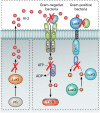Regulatory Mechanisms of the LuxS/AI-2 System and Bacterial Resistance
- PMID: 31383657
- PMCID: PMC6761564
- DOI: 10.1128/AAC.01186-19
Regulatory Mechanisms of the LuxS/AI-2 System and Bacterial Resistance
Abstract
The quorum-sensing (QS) system is an intercellular cell-cell communication mechanism that controls the expression of genes involved in a variety of cellular processes and that plays critical roles in the adaption and survival of bacteria in their environment. The LuxS/AI-2 QS system, which uses AI-2 (autoinducer-2) as a signal molecule, has been identified in both Gram-negative and Gram-positive bacteria. As one of the important global regulatory networks in bacteria, it responds to fluctuations in the numbers of bacteria and regulates the expression of a number of genes, thus affecting cell behavior. We summarize here the known relationships between the LuxS/AI-2 system and drug resistance, discuss the inhibition of LuxS/AI-2 system as an approach to prevent bacterial resistance, and present new strategies for the treatment of drug-resistant pathogens.
Keywords: LuxS/AI-2 system; bacterial resistance; biofilm formation; efflux pump.
Copyright © 2019 American Society for Microbiology.
Figures


Similar articles
-
AI-2/LuxS Quorum Sensing System Promotes Biofilm Formation of Lactobacillus rhamnosus GG and Enhances the Resistance to Enterotoxigenic Escherichia coli in Germ-Free Zebrafish.Microbiol Spectr. 2022 Aug 31;10(4):e0061022. doi: 10.1128/spectrum.00610-22. Epub 2022 Jun 14. Microbiol Spectr. 2022. PMID: 35700135 Free PMC article.
-
The LuxS/AI-2 system of Streptococcus suis.Appl Microbiol Biotechnol. 2018 Sep;102(17):7231-7238. doi: 10.1007/s00253-018-9170-7. Epub 2018 Jun 25. Appl Microbiol Biotechnol. 2018. PMID: 29938319 Review.
-
Effect of the luxS gene on biofilm formation and antibiotic resistance by Salmonella serovar Dublin.Food Res Int. 2018 May;107:385-393. doi: 10.1016/j.foodres.2018.02.039. Epub 2018 Feb 17. Food Res Int. 2018. PMID: 29580499
-
LuxS/AI-2 system is involved in fluoroquinolones susceptibility in Streptococcus suis through overexpression of efflux pump SatAB.Vet Microbiol. 2019 Jun;233:154-158. doi: 10.1016/j.vetmic.2019.05.006. Epub 2019 May 6. Vet Microbiol. 2019. PMID: 31176402
-
Establishing bacterial communities by 'word of mouth': LuxS and autoinducer 2 in biofilm development.Nat Rev Microbiol. 2008 Aug;6(8):635-43. doi: 10.1038/nrmicro1916. Epub 2008 Jun 9. Nat Rev Microbiol. 2008. PMID: 18536728 Review.
Cited by
-
Research Progress and Hopeful Strategies of Application of Quorum Sensing in Food, Agriculture and Nanomedicine.Microorganisms. 2022 Jun 10;10(6):1192. doi: 10.3390/microorganisms10061192. Microorganisms. 2022. PMID: 35744710 Free PMC article.
-
Quorum Sensing: Not Just a Bridge Between Bacteria.Microbiologyopen. 2025 Mar;14(1):e70016. doi: 10.1002/mbo3.70016. Microbiologyopen. 2025. PMID: 40159675 Free PMC article. Review.
-
Targeting the Holy Triangle of Quorum Sensing, Biofilm Formation, and Antibiotic Resistance in Pathogenic Bacteria.Microorganisms. 2022 Jun 16;10(6):1239. doi: 10.3390/microorganisms10061239. Microorganisms. 2022. PMID: 35744757 Free PMC article. Review.
-
Virulence and resistance gene analysis of Rothia nasimurium by whole gene sequencing.Sci Rep. 2025 Mar 27;15(1):10583. doi: 10.1038/s41598-025-95405-z. Sci Rep. 2025. PMID: 40148435 Free PMC article.
-
Inhibitory effect of andrographolide on the expression of key regulatory genes in Staphylococcus epidermidis biofilm formation.J Mol Histol. 2024 Dec 23;56(1):53. doi: 10.1007/s10735-024-10295-1. J Mol Histol. 2024. PMID: 39714542
References
Publication types
MeSH terms
Substances
LinkOut - more resources
Full Text Sources
Research Materials

